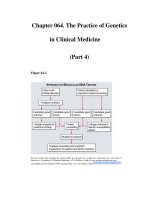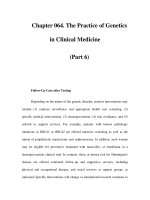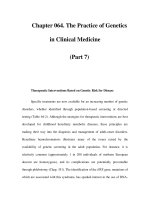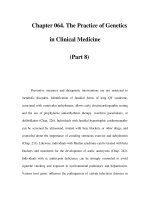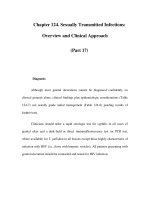Chapter 124. Sexually Transmitted Infections: Overview and Clinical Approach (Part 19) Ulcerative docx
Bạn đang xem bản rút gọn của tài liệu. Xem và tải ngay bản đầy đủ của tài liệu tại đây (13.76 KB, 5 trang )
Chapter 124. Sexually Transmitted Infections:
Overview and Clinical Approach
(Part 19)
Ulcerative Genital or Perianal Lesions: Treatment
Immediate syndrome-based treatment for acute genital ulcerations (after
collection of all necessary hdiagnostic specimens at the first visit) is often
appropriate before all test results become available, because patients with typical
initial or recurrent episodes of genital or anorectal herpes can benefit from prompt
oral antiviral therapy (Chap. 172); because early treatment of sexually transmitted
causes of genital ulcers decreases further transmission; and because some patients
do not return for test results and treatment. The patient with nonvesicular
ulcerative lesions who may not return for follow-up or may not discontinue sexual
activity should receive initial treatment for syphilis, together with empirical
therapy for chancroid if there has been an exposure in an area where chancroid
occurs or if regional lymph node suppuration is evident. In resource-poor settings
lacking ready access to diagnostic tests, this approach to syndromic treatment for
syphilis and chancroid has helped bring these two diseases under control. Finally,
empirical antimicrobial therapy may be indicated if ulcers persist and the
diagnosis remains unclear after a week of observation despite attempts to diagnose
herpes, syphilis, and chancroid.
Proctitis, Proctocolitis, Enterocolitis, and Enteritis
Sexually acquired proctitis, with inflammation limited to the rectal mucosa
(the distal 10–12 cm), results from direct rectal inoculation of typical STD
pathogens. In contrast, inflammation extending from the rectum to the colon
(proctocolitis), involving both the small and the large bowel (enterocolitis), or
involving the small bowel alone (enteritis) can result from ingestion of typical
intestinal pathogens through oral-anal exposure during sexual contact. Anorectal
pain and mucopurulent, bloody rectal discharge suggest proctitis or protocolitis.
Proctitis commonly produces tenesmus (causing frequent attempts to defecate, but
not true diarrhea) and constipation, whereas proctocolitis and enterocolitis more
often cause true diarrhea. In all three conditions, anoscopy usually shows mucosal
exudate and easily induced mucosal bleeding (i.e., a positive "wipe test"),
sometimes with petechiae or mucosal ulcers. Exudate should be sampled for
Gram's staining and other microbiologic studies. Sigmoidoscopy or colonoscopy
shows inflammation limited to the rectum in proctitis or disease extending at least
up into the sigmoid colon in proctocolitis.
The AIDS era brought an extraordinary shift in the clinical and etiologic
spectrum of intestinal infections among homosexual men. The number of cases of
the acute intestinal STIs described above fell as high-risk sexual behaviors became
less common in this group.
At the same time, the number of AIDS-related opportunistic intestinal
infections increased rapidly, many associated with chronic or recurrent symptoms.
The incidence of these infections has since fallen with increasingly effective
antiretroviral therapy.
Two species initially isolated in association with intestinal symptoms in
homosexual men are now known as Helicobacter cinaedi and Helicobacter
fennelliae, and both have subsequently been isolated from the blood of HIV-
infected men with a syndrome of multifocal dermatitis and arthritis.
Acquisition of HSV, N. gonorrhoeae, or C. trachomatis (now again
including LGV strains of C. trachomatis) during receptive anorectal intercourse
causes most cases of infectious proctitis in women and homosexual men. Primary
and secondary syphilis can also produce anal or anorectal lesions, with or without
symptoms. Gonococcal or chlamydial proctitis typically involves the most distal
rectal mucosa and the anal crypts and is clinically mild, without systemic
manifestations. In contrast, primary proctitis due to HSV and proctocolitis due to
the strains of C. trachomatis that cause LGV usually produce severe anorectal pain
and often cause fever. Perianal ulcers and inguinal lymphadenopathy, most
commonly due to HSV, can also occur in LGV or syphilis.
Sacral nerve root radiculopathies, usually presenting as urinary retention,
laxity of the anal sphincter, or constipation, may complicate primary herpetic
proctitis. In LGV, rectal biopsy typically shows crypt abscesses, granulomas, and
giant cells—findings resembling those in Crohn's disease; such findings should
always prompt rectal culture and serology for LGV, which is a curable infection.
Syphilis can also produce rectal granulomas, usually in association with
infiltration by plasma cells or other mononuclear cells.
Syphilis, LGV, and HSV infection involving the rectum can produce
perirectal adenopathy that is sometimes mistaken for malignancy; syphilis, LGV,
HSV infection, and chancroid involving the anus can produce inguinal
adenopathy, because anal lymphatics drain to inguinal lymph nodes.
Diarrhea and abdominal bloating or cramping pain without anorectal
symptoms and with normal findings on anoscopy and sigmoidoscopy occur with
inflammation of the small intestine (enteritis) or with proximal colitis. In
homosexual men without HIV infection, enteritis is often attributable to Giardia
lamblia. Sexually acquired proctocolitis is most often due to Campylobacter or
Shigella spp.



